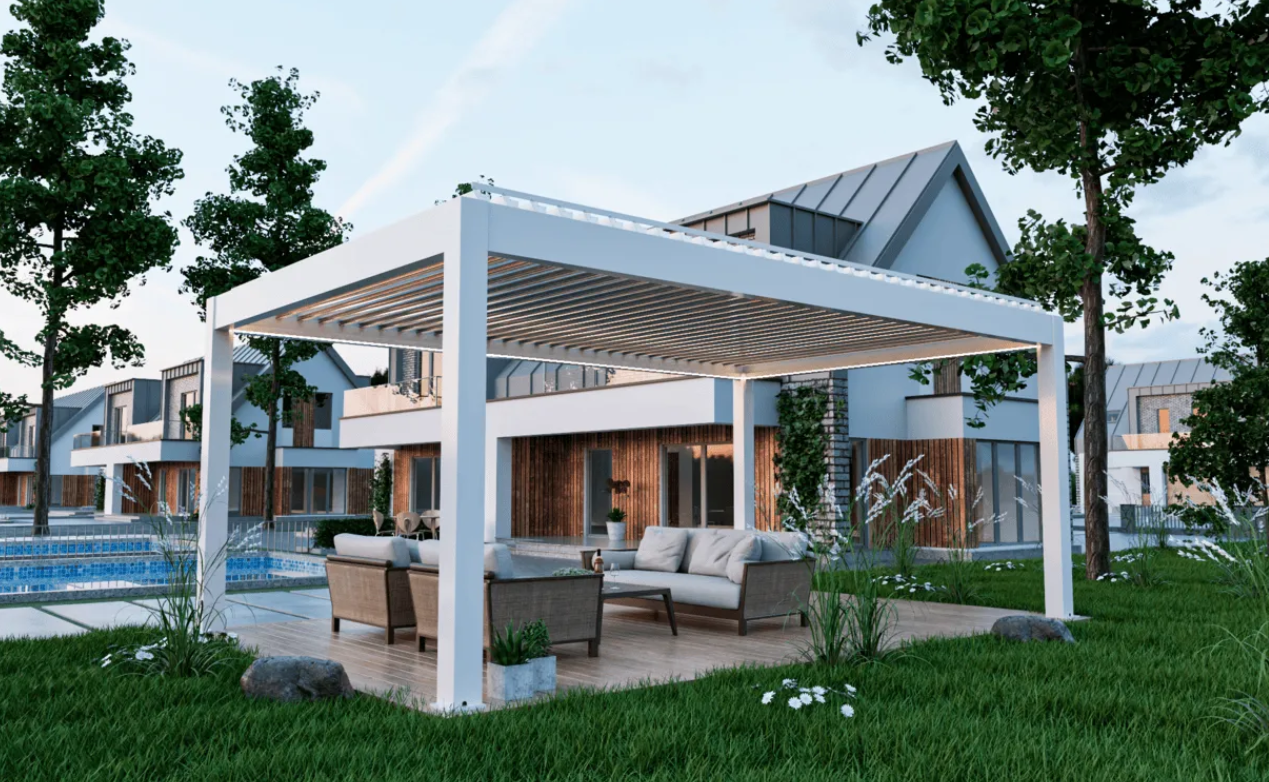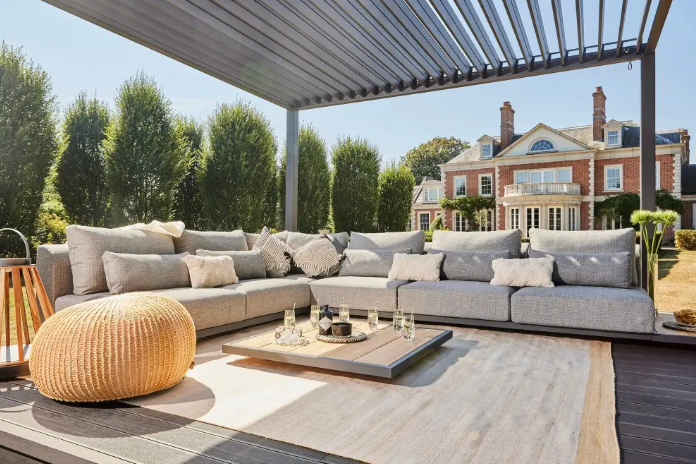Создаем индивидуальность вашего сада с помощью отдельно стоящих пергол
Архитектурный акцент без привязки к строительным конструкциям
Отдельно стоящий пергола устанавливается на собственной территории, превращая сады в выдающиеся архитектурные элементы, без необходимости крепления к зданиям или стенам. Эти независимые конструкции придают гибкость дизайну сада, улучшая визуальную привлекательность открытых пространств и позволяя людям персонализировать их в соответствии со своими предпочтениями. У домовладельцев также имеется широкая гамма вариантов выбора материалов. Некоторые предпочитают элегантные алюминиевые рамы, другие выбирают дерево с эффектом состаривания и винтажный вид, а есть и те, кто любит простые стальные конструкции. Ландшафтные профессионалы, такие как Пит Оудольф и Томас Черч, часто включают такие автономные перголы в свои проекты, создавая дизайны, которые естественным образом сочетаются с окружением, но при этом остаются заметными архитектурными акцентами. Их подход демонстрирует, как простой элемент может стать частью гармоничного целого.
Настраиваемая площадь для интеграции в ландшафт
Отдельно стоящие перголы имеют реальное преимущество в вопросе вписывания в различные садовые пространства. Они предлагают гибкие габариты, которые хорошо сочетаются с любыми особенностями ландшафта, присутствующими в зоне установки. Достижение хороших результатов действительно зависит от точного измерения параметров и обдумывания того, как всё будет смотреться вместе с растениями, террасами и дорожками в окружающей области. Владельцы садов часто проявляют креативность в выборе форм и компоновок — от небольших уютных уголков до крупных открытых конструкций, покрывающих обширные площади. Корректировка размеров и расположения позволяет убедиться, что пергола будет восприниматься как естественная часть сада, а не что-то добавленное сверху. Такая интеграция не только выглядит лучше, но и делает внешнее пространство более функциональным и удобным для повседневного использования.
Сохранение визуального потока в открытых конструкциях
Отдельно стоящие перголы помогают создать отдельные зоны в садах и на террасах, не нарушая общий вид пространства. Эти конструкции позволяют домовладельцам выделить места для различных занятий, таких как отдых, развлечения гостей или прием пищи на улице. Если разместить их стратегически вдоль естественных линий обзора на участке, перголы становятся акцентными точками, привлекающими внимание с нескольких направлений и создавая уютные уголки на открытом воздухе. Дома с тщательно продуманными внешними пространствами также имеют тенденцию стоить больше на рынке. Некоторые исследования показывают, что недвижимость с привлекательными зонами для жизни на открытом воздухе может увеличить свою стоимость на 20–30%. Включение пергол в ландшафтный дизайн не только делает задний двор более функциональным, но и добавляет долгосрочную ценность собственности, не выглядя слишком преднамеренно.
Преимущество циркуляции воздуха в отдельно стоящих перголах
вентиляция на 360 градусов для комфортного отдыха
Отдельно стоящие перголы обеспечивают хорошее проветривание со всех сторон, что делает их отличным решением для повышения комфорта на улице. Они пропускают естественный воздушный поток, позволяя людям оставаться прохладными даже в жаркую погоду. Открытые стропила и регулируемые панели значительно способствуют циркуляции воздуха, обеспечивая при этом некоторую защиту от солнца или мелкого дождя. В журнале «Journal of Environmental Management» было опубликовано исследование, в котором рассматривалось, как современные конструкции пергол делают зоны отдыха гораздо более комфортными за счет улучшенного воздушного потока. Прекрасной особенностью таких конструкций является то, что они позволяют любителям садов и открытых зон отдыха проводить время на улице независимо от погоды.

Контроль микроклимата для чувствительных растений
Отдельно стоящие перголы действительно играют большую роль в создании небольших зон защиты для растений, которые плохо переносят суровые погодные условия. Они обеспечивают частичную тень и защиту от ветра, что помогает поддерживать более стабильный температурный и влажностный режим, необходимый для выживания многих нежных растений. Орхидеи и папоротники особенно хорошо растут под перголами, поэтому садоводы, желающие выращивать эти капризные, но красивые растения, обязательно должны рассмотреть возможность их установки. Садовые эксперты часто подчеркивают важность контролируемого климата для успешного выращивания растений, а перголы позволяют создать как раз подходящие условия для разных видов растений, не прибегая к дорогостоящему оборудованию или сложным системам.
Оптимизация сквозняка в летние месяцы
Правильно установленные и построенные беседки могут значительно улучшить циркуляцию воздуха в летний период. Если их правильно расположить с учетом направления ветра, они создают естественное охлаждение, делающее пребывание на улице гораздо более комфортным. Место, где устанавливается подобная конструкция, играет большую роль в ее эффективности. Некоторые люди отмечают, что ощущают значительное снижение температуры, если беседка установлена правильно. Специалисты по ландшафтному дизайну подтверждают этот эффект на практике. Им приходилось работать над проектами, в которых грамотное размещение беседок превращало знойные участки в приятные зоны отдыха, где люди действительно хотят проводить время. Правильная установка не только делает пребывание на улице прохладнее, но и выглядит эстетично, превращая обычный задний двор в нечто особенное.
Управление солнечным светом посредством регулируемого дизайна
Системы поворотных жалюзи для точного затенения
Системы с вращающимися ламелями дают домовладельцам удивительную возможность контролировать количество солнечного света, попадающего в их зоны на открытом воздухе, позволяя в течение дня регулировать степень затенения в зависимости от ситуации. Они уменьшают вредное воздействие ультрафиолетовых лучей и предотвращают накопление избыточного тепла, делая пребывание на улице комфортным, а не неприятным. Регулируемые ламели позволяют корректировать их положение в зависимости от местоположения солнца в разное время суток, обеспечивая всегда нужный уровень затенения. Джо Рабуин из Belgard Outdoor Living часто подчеркивает, что такие системы действительно преобразуют задние дворы, превращая пространства, которые иначе были бы слишком жаркими или яркими, в удобные зоны, где семьи могут собираться в комфорте, оставаясь на естественном свете.
Стратегии защиты от ультрафиолета для уличной мебели
Защита уличной мебели от ультрафиолетового излучения требует определенных усилий и правильного выбора материалов. Отдельно стоящий пергола может стать отличным решением, создавая тенистую зону, в которой мебель будет защищена от вредного воздействия солнца. По наблюдениям Брайана Клэйтона из GreenPal, большинство людей находят, что ткани из полиэстера или акрила лучше выдерживают погодные условия по сравнению с обычным хлопком. Он всегда подчеркивает важность защиты от ультрафиолета, если люди хотят, чтобы их садовые гарнитуры служили дольше. Его основная рекомендация? Выбирать перголы с регулируемыми балками или покрытиями, которые можно опускать при необходимости. Этот простой шаг играет большую роль в сохранении дорогостоящей уличной мебели в хорошем состоянии.
Техники адаптации к сезонным углам
Изменение угла наклона пергол в разное время года существенно влияет на то, сколько солнечного света проходит, и насколько тенисто будет на улице. Владельцам домов стоит задуматься об установке современных моторизованных жалюзи, если они хотят получить удобную систему регулировки без лишних усилий. Те, кто действительно управляют настройками своей перголы в зависимости от погоды, проводят гораздо больше времени на улице при различных погодных условиях. Возможность корректировать эти конструкции делает их полезными в любое время года, что особенно важно, потому что положение солнца постоянно меняется с лета на зиму. Большинство специалистов посоветуют заинтересованным людям, строящим такую конструкцию, подбирать стиль перголы в соответствии с характерными погодными условиями региона, поскольку это значительно улучшает комфорт при использовании данного пространства.
Гибкость установки и подготовка основания
Объяснение минимальных требований к фундаменту
Одним из больших преимуществ беседок, стоящих отдельно, является то, что по сравнению с обычными конструкциями они требуют минимальной подготовки основания, что делает их довольно эффективным решением для создания современных открытых жилых пространств, которые сейчас так популярны. У домовладельцев также есть несколько вариантов установки таких сооружений. Винтовые сваи отлично подходят для многих участков, можно также использовать бетонные плиты, а в последнее время появились и некоторые новые методы. Суть в том, что люди могут выбрать то, что лучше всего подходит для конкретной ситуации их участка, не выкапывая всё подряд. Благодаря такой гибкости в размещении на земле, монтаж на самом деле происходит гораздо быстрее, чем многие ожидают. Мы сталкивались с ситуациями, когда сборка беседки, стоящей отдельно, занимала примерно вдвое меньше времени, чем строительство чего-либо более традиционного с нуля.
Пошаговые руководства по сборке своими руками
Говоря о капитальных перголах, наиболее заметным является их простота сборки с использованием наборов для самостоятельной установки. Владельцам домов, которые хотят украсить свой задний двор, не требуется помощь экспертов, благодаря этой доступности. Большинство наборов поставляются с инструкциями, которые подробно объясняют каждый этап, а многие производители теперь дополнительно предоставляют онлайн-видео. Пользователи действительно отмечают довольно хорошие результаты от самостоятельной сборки таких конструкций. Даже люди, которые не слишком опытны в обращении с инструментами, справляются с этим вполне успешно, что значительно снижает обычное разочарование, связанное с домашними проектами.
Сохранение существующего ландшафта во время установки
При установке отдельно стоящих пергол важно помнить, насколько необходимо оставить окружающий ландшафт практически нетронутым. В этом вопросе правильное планирование играет ключевую роль, особенно если на участке уже растут растения или обитает дикая природа. До начала земляных работ умные домовладельцы заранее набрасывают схему, где отмечают текущее расположение всех объектов, чтобы впоследствии никто случайно их не повредил. Большинство специалистов по благоустройству ландшафта рекомендуют использовать экологичные методы, позволяющие сохранить естественный баланс природы. В конце концов, никто не хочет превратить свой сад в нечто искусственное из-за добавления красивой перголы. Забота о существующих элементах ландшафта в итоге создаёт более качественные зоны для отдыха на открытом воздухе, ведь всем приятнее проводить время среди настоящих растений, а не искусственных.
Выбор материалов для стационарного и портативного использования
Преимущества легкой алюминиевой рамы
Легкий алюминий является отличным материалом для выбора беседок, так как он служит дольше и требует почти нулевого ухода по сравнению с другими вариантами. Что касается устойчивости к суровым погодным условиям, алюминий справляется намного лучше, чем дерево. Нет коробления, гниения, и уж точно не нужно постоянно красить конструкцию, что раздражает всех. Такой минимальный уход с течением времени дает ощутимую экономическую выгоду. Компании, такие как Gosforth Outdoor, завоевали репутацию, создавая подобные алюминиевые конструкции, которые также поддерживаются надежным гарантийным обслуживанием. Большинство гарантий покрывают такие вещи, как коррозия и повреждения конструкции в течение нескольких лет, что дает домовладельцам дополнительное чувство уверенности при инвестициях в зоны отдыха на открытом воздухе.
Варианты обработки древесины для защиты от погодных условий
Деревянные беседки требуют надлежащего ухода, чтобы прослужить в любое время года. Нанесение водостойких материалов, таких как герметик, морилка или краска, помогает защитить древесину от влаги и предотвратить повреждение от солнца. Также важно правильно выбрать тип древесины в зависимости от места установки. Кедр и красное дерево выделяются тем, что естественным образом лучше сопротивляются гниению и вредителям по сравнению с другими породами дерева. Многие эксперты по садоводству, включая ландшафтного специалиста Дэнни Липфорда, подчеркивают, что регулярное обслуживание этих конструкций позволяет дольше сохранять их привлекательный внешний вид и избежать дорогостоящей замены в будущем. Регулярные проверки и новые слои защитных покрытий значительно способствуют сохранению как функциональности, так и красоты беседок.
Быстроразъемная фурнитура для возможного перемещения
Перголы с быстроразъемной фурнитурой намного упрощают процесс демонтажа и перемещения конструкции при необходимости. Садоводы часто считают такую возможность очень полезной, если им нужно внести изменения из-за смены времен года или обновления ландшафта. Возможность просто поднять перголу и переместить её в другое место позволяет избежать множества трудностей, предоставляя пользователям гораздо больше вариантов для оформления сада. Архитекторы-садовники, такие как Martha Schwartz Partners, подчеркивают важность подобных систем для создания действительно гибких и функциональных открытых пространств. Главная идея заключается в том, что перголы остаются полезным элементом даже по мере роста и изменения садов, сочетая прочность конструкции со свободой перемещения при необходимости.
Факторы долгосрочной ценности и адаптируемости
Анализ соотношения стоимости/выгоды между стационарными и съемными моделями
Перед покупкой перголы стоит подумать, какая модель — стационарная или мобильная — будет более целесообразной с точки зрения бюджета. Стационарные отдельно стоящие перголы обычно служат дольше, поскольку они изготавливаются из прочных материалов, таких как древесина, обработанная под давлением, или металлические рамы. Эти конструкции требуют меньшего ухода в течение многих лет, так как им не нужно регулировать положение из сезона в сезон. В свою очередь, мобильные перголы обеспечивают владельцам садов большую свободу. Их можно просто поднять и переместить в другое место, когда меняются планы по благоустройству, не нужно полностью разбирать конструкцию. Обычно установка обходится дешевле, так как большинство мобильных моделей поставляются частично собранными или с простыми инструкциями по монтажу. Домовладельцы, проживающие в регионах, где погодные условия значительно меняются в течение года, часто экономят деньги в долгосрочной перспективе, выбирая съемные конструкции. Одна семья из Колорадо сообщила, что сократила расходы на проекты на открытом воздухе почти вдвое после перехода на использование мобильных пергол всякий раз, когда они хотели обновить пространство своего заднего двора.
Обеспечение роста для вьющихся растений
Перголы очень хорошо подходят для выращивания вьющихся растений, добавляя садам и террасам красоту и очарование. Каркас перголы поддерживает различные виды зелени — например, вистерию, климатис или, возможно, жимолость. Эти растения хорошо растут, если у них есть прочная опора для лазания. Когда растения начинают цвести в разное время года, весь участок постоянно преображается. Специалисты советуют выбирать растения, подходящие под местные погодные условия. Если человек живет в регионе с мягкими зимами, то жасмин и пассифлора могут стать хорошим выбором. А в южных регионах, где тепло большую часть года, бугенвиллия становится отличным вариантом, поскольку она практически круглый год радует цветом и листвой.
Возможность переконфигурации во время переустройства двора
Отдельно стоящие перголы — это действительно универсальные конструкции, которые отлично подходят, когда люди хотят изменить дизайн своего двора в будущем. Их преимущество заключается в том, что домовладельцам не нужно разбирать всё из-за изменений в предпочтениях или планах ландшафтного дизайна со временем. Современные сады довольно часто меняют свой внешний вид, поэтому наличие чего-то адаптируемого делает их особенно привлекательными. Садоводы ценят простоту работы с этими конструкциями при обновлении открытого пространства. Люди, которые устанавливали перголы, рассказывают, как легко добавлять новые места для сидения или даже обустраивать мини-кухни неподалёку без особых усилий. Эти конструкции легко вписываются в любой новый план, что объясняет, почему многие считают их достойной инвестицией, несмотря на начальные затраты.
Раздел часто задаваемых вопросов
Какие преимущества использования отдельно стоящих пергол?
Отдельно стоящие перголы обеспечивают гибкость в дизайне без необходимости подключения к существующим конструкциям. Они повышают эстетическую привлекательность, обеспечивают вентиляцию на 360 градусов, создают микроклимат для чувствительных растений и могут адаптироваться к различным планировкам сада.
Как отдельно стоящие перголы регулируют воздействие солнечного света и ультрафиолета?
Отдельно стоящие перголы регулируют солнечный свет за счет регулируемых элементов конструкции, таких как системы поворотных жалюзи и адаптация углов в зависимости от времени года. Они обеспечивают защиту от УФ-излучения для уличной мебели благодаря использованию материалов, устойчивых к атмосферным воздействиям.
Можно ли легко установить отдельно стоящие перголы?
Да, отдельно стоящие перголы имеют минимальные требования к фундаменту, что часто позволяет быструю и более экономически эффективную установку с использованием методов, таких как земляные шурупы или бетонные плиты. Для простой сборки доступны комплекты своими руками.
Подходят ли отдельно стоящие перголы для выращивания вьющихся растений?
Действительно, отдельно стоящие перголы поддерживают лианы, такие как вистерия, клематис и жимолость, что усиливает естественную красоту открытых пространств. Они обеспечивают прочный каркас для оптимального роста растений.
Какие материалы рекомендуются для постройки отдельно стоящих пергол?
Легкий алюминий и обработанная древесина — популярные материалы для пергол. Алюминий прочный и устойчивый к погодным условиям, а обработанная древесина естественным образом устойчива к гниению и вредителям.
Содержание
-
Создаем индивидуальность вашего сада с помощью отдельно стоящих пергол
- Архитектурный акцент без привязки к строительным конструкциям
- Настраиваемая площадь для интеграции в ландшафт
- Сохранение визуального потока в открытых конструкциях
- Преимущество циркуляции воздуха в отдельно стоящих перголах
- вентиляция на 360 градусов для комфортного отдыха
- Контроль микроклимата для чувствительных растений
- Оптимизация сквозняка в летние месяцы
- Управление солнечным светом посредством регулируемого дизайна
- Системы поворотных жалюзи для точного затенения
- Стратегии защиты от ультрафиолета для уличной мебели
- Техники адаптации к сезонным углам
- Гибкость установки и подготовка основания
- Объяснение минимальных требований к фундаменту
- Пошаговые руководства по сборке своими руками
- Сохранение существующего ландшафта во время установки
- Выбор материалов для стационарного и портативного использования
- Преимущества легкой алюминиевой рамы
- Варианты обработки древесины для защиты от погодных условий
- Быстроразъемная фурнитура для возможного перемещения
- Факторы долгосрочной ценности и адаптируемости
- Анализ соотношения стоимости/выгоды между стационарными и съемными моделями
- Обеспечение роста для вьющихся растений
- Возможность переконфигурации во время переустройства двора
-
Раздел часто задаваемых вопросов
- Какие преимущества использования отдельно стоящих пергол?
- Как отдельно стоящие перголы регулируют воздействие солнечного света и ультрафиолета?
- Можно ли легко установить отдельно стоящие перголы?
- Подходят ли отдельно стоящие перголы для выращивания вьющихся растений?
- Какие материалы рекомендуются для постройки отдельно стоящих пергол?



